Shopify B2B Wholesale: An Ultimate Guide for Merchants

The digital shift in B2B commerce isn’t just coming – it’s here.
In a world where direct-to-consumer (DTC) brands often steal the spotlight, it’s easy to overlook the $7.7 trillion opportunity in B2B eCommerce. That’s right – the global wholesale market is more than double the size of DTC commerce, and it’s growing at an impressive rate of 18% annually.
If you’re a manufacturer, distributor, or brand considering Shopify B2B Wholesale or wondering how to optimize your wholesale operations, you’re at the right place!
Modern B2B buyers expect shopping experiences that rival the personalization and convenience they enjoy as consumers, with 43% preferring to make purchases without any interaction with sales representatives.
This guide will walk you through how Shopify Plus is transforming B2B commerce by:
- addressing the common challenges of wholesale selling,
- offering a brand-forward approach, and
- providing the tools needed to create exceptional customer experiences.
So, let’s get started!
What is Shopify B2B Wholesale?

Shopify B2B is a powerful set of built-in features that lets you sell directly to business customers—all from your Shopify admin and online store. Whether you want to run a single store that serves both B2B and D2C (direct-to-consumer) customers, or create a dedicated B2B storefront, Shopify gives you the flexibility to choose what works best for your business.
To get started, simply set up your B2B customers as companies in your Shopify admin. From there, you can personalize the buying experience for each customer—customizing pricing, currency, product visibility, payment and shipping options, and even store content to meet their unique needs.
How Does Shopify B2B Work?
Shopify B2B allows businesses to sell directly to other businesses (B2B) using their existing online store or a dedicated B2B store. It offers features like company profiles, custom pricing, payment terms, and B2B checkout, streamlining the wholesale buying process.
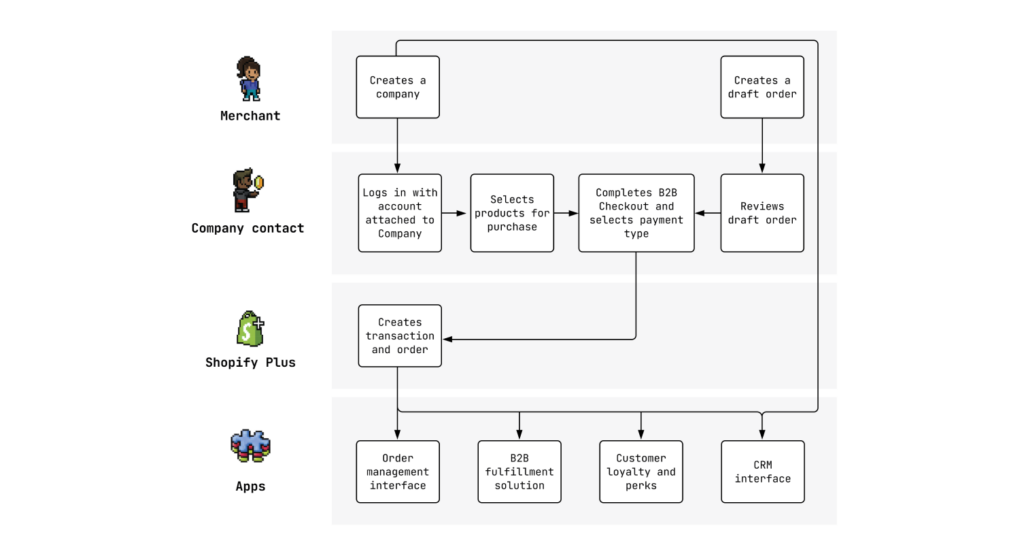
Key B2B Features of Shopiy Plus
B2B on Shopify integrates the most essential wholesale features right into the core of Shopify.
| No. | B2B Feature | Description |
| 1 | Companies | Using Companies as the foundation, merchants can develop a streamlined wholesale operating model, with processes and workflows that scale with their business. |
| 2 | Catalogs | Offer a personalized buying experience with curated product catalogs and price lists, flexible purchasing rules, and discounts, all assigned to a specific buyer or location. |
| 3 | Flexible payments | Streamlining the payment process to get paid on time, and on their terms. |
| 4 | Storefront | Designed for B2B buying with a DTC-like experience |
| 5 | Self-serve purchasing | Scale operations by empowering B2B buyers with hands-off purchasing and easy account management. |
| 6 | B2B checkout | Customize each buyer’s checkout with discounts, payment options, and shipping rates, based on logic that fits their B2B workflows. Built with Shopify Functions. |
| 7 | APIs and integrations | Solutions that meet the complex needs of their business. |
Before you explore more about it, let’s examine the typical obstacles that B2B merchants usually face when selling wholesale.
What are the Common Challenges in B2B Selling?
As industry experts, we’ve spoken with dozens of B2B merchants over the years, and most face similar hurdles that prevent them from fully capitalizing on digital opportunities.
1—The Technology Struggle
Many wholesale businesses are trapped using systems designed for a different era. I recently visited a manufacturer still using software from 2005 to manage their wholesale operations! They knew it was holding them back, but the fear of disrupting existing processes kept them from upgrading.
Legacy technology creates daily headaches for your team. When orders come in through multiple channels (email, phone, sales reps), someone has to manually enter them into your system. This not only wastes precious hours but introduces costly errors.
One merchant told me they discovered they’d been losing approximately $45,000 annually just from data entry mistakes.
What’s more, when your DTC store runs on one platform and your B2B operations on another, you’re essentially running two separate businesses. Your inventory gets out of sync, customer data lives in different places, and generating comprehensive reports becomes nearly impossible.
2—When “Good Enough” Isn’t Good Enough
The expectation gap between what B2B buyers want and what most platforms deliver is widening every day.
Today’s B2B buyers aren’t comparing your wholesale portal to other wholesale websites—they’re comparing it to their experience on Amazon and other sophisticated consumer sites.
The stats don’t lie: a shocking 67% of B2B buyers have abandoned suppliers because their digital experience was subpar. Remember when clunky websites and confusing checkout processes were acceptable in B2B? Those days are gone.
With 70% of B2B buyers now being millennials, this sentiment is becoming the norm, not the exception. Custom pricing is another major pain point. Many platforms force you to show the same prices to everyone or create convoluted workarounds.
3—Hidden Costs of Manual Processes
The problem with running B2B sales through manual processes isn’t just inefficiency—it’s the opportunity cost. When your team spends hours processing orders or reconciling data between systems, they’re not focusing on growth strategies or building customer relationships.
Consider the wholesale cycle: A sales rep takes an order at a trade show, writes it on paper, emails it to the office, where someone manually enters it into your system, then someone else checks inventory, generates an invoice, coordinates shipping… the list goes on.
Each step introduces delays and probable errors.
4—When Customers Can’t Self-Serve, Everyone Suffers
The modern B2B buyer doesn’t want to wait for a sales rep to call them back. They want to check inventory, place orders, and track shipments at their convenience—even outside business hours.
A stationery wholesaler shared that after enabling self-service ordering, they saw 40% of their orders coming in between 7 PM and 6 AM—times when their sales team wasn’t even available. Without self-service capability, those orders might have gone to competitors.
And it’s not just about convenience. When customers can browse your full catalog online (rather than the selections a sales rep might highlight), they often discover products they wouldn’t have otherwise considered.
5—Cost of Communication Breakdowns
Poor integration between your systems creates communication gaps that impact your bottom line. For example:
- When your inventory doesn’t update in real-time across platforms, you risk overselling or missing sales opportunities.
- When shipping information doesn’t flow automatically between systems, customers don’t get timely updates about their orders.
A furniture wholesaler recently told me they lost a $45,000 account because they couldn’t provide the order tracking transparency their customer needed. The customer switched to a competitor with a more integrated system that provided real-time visibility into order status and shipping.
6—Growth Requires Scalable Solutions
Perhaps the most significant challenge is that manual B2B processes simply don’t scale. They might work when you have 10 wholesale customers, but what about 100? Or 1,000?
As one apparel manufacturer put it, “We hit a ceiling where adding more wholesale accounts actually decreased our profitability because our systems couldn’t handle the volume efficiently.”
They were turning away potential business because their operations couldn’t scale—a painful position for any growth-minded company.
The good news is that these challenges aren’t so big that you can’t overcome.
First, take a moment to identify which of these pain points resonate most with your business—that awareness is the first step toward transformation.
Next, we’ll understand how Shopify Plus has become the platform for forward-thinking B2B merchants looking to overcome these challenges.
Why Choose Shopify Plus for B2B?
When you’re juggling wholesale and retail sales, finding the right platform can feel like searching for a unicorn.
B2B on Shopify Plus isn’t just another feature bolted onto an existing system—it’s built right into Shopify’s core, designed specifically for merchants who need to handle both worlds efficiently.
Here’s why you should consider Shopify Plus for your B2B business:
1. Unified Platform for DTC and B2B Operations
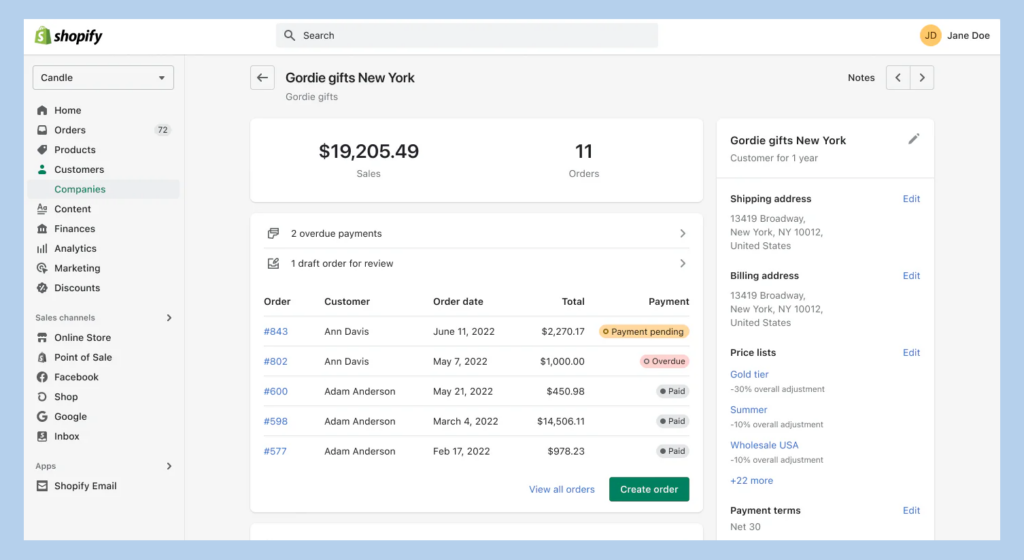
Running separate systems for your retail and wholesale business is like trying to drive two cars at once. It’s exhausting, expensive, and something always falls through the cracks.
With Shopify Plus, you can manage everything from one dashboard. Your inventory updates across both channels simultaneously. Your reports show the complete picture of your business, with options to filter and drill down when needed.
You can choose what works best for your business model: either blend your B2B and retail stores together or keep them separate. A blended approach means less administrative work, while a dedicated B2B store gives you more freedom to customize the wholesale experience.
2. Customer-specific Pricing and Catalogs
What makes B2B fundamentally different from retail is “relationships”.
Each of your wholesale customers likely has their own negotiated terms and pricing structure.
Shopify Plus lets you create unique company profiles for each wholesale customer. You can set custom price lists that reflect your relationship with that buyer, their order volume, or other factors that influence your pricing decisions.
You can even curate specific product catalogs for different customers or locations.
This means when your wholesale buyers log in, they see only what’s relevant to them—their negotiated prices, available products, and purchase rules. It feels like a store built just for them, which is exactly what today’s B2B buyers expect.
3. Automated Workflows
Remember when processing wholesale orders meant mountains of paperwork and endless email chains?
Those days can be behind you.
Shopify Plus empowers your wholesale customers with self-service purchasing. They can manage their own company accounts, add team members, and place orders whenever it’s convenient for them—no waiting for your sales team to be available.
You can customize their checkout experience with payment options that make sense for their account, appropriate shipping rates, and any applicable discounts. The system supports flexible payment terms that match your existing business practices, whether that’s net-30, credit card, or wire transfers.
The beauty of this automation is that it frees your team from administrative busywork so they can focus on building relationships and growing your business.
4. Support for LTL/FTL Shipping Methods
When you’re shipping pallets instead of parcels, your logistics needs change dramatically. B2B on Shopify Plus understands this.
The platform supports less-than-truckload (LTL) shipping for those mid-sized orders that don’t fill an entire trailer, as well as full-truckload (FTL) shipping for your largest customers.
You can set custom shipping rules based on order minimums or product volumes, ensuring that your shipping practices align with your business model. And if you need to split shipments—maybe some items are in stock while others aren’t—the system can handle that too.
5. Integration with ERP Systems and 3PL Services
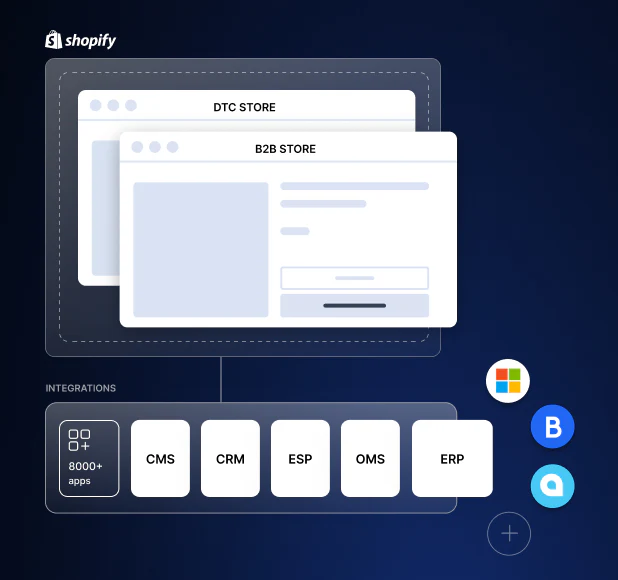
For many B2B businesses, their ERP system is the heart of their operation. Shopify Plus plays nicely with these systems through open APIs and pre-built integrations.
If you’re working with major retailers that require EDI capabilities, or if you rely on third-party logistics providers, Shopify Plus has you covered. These integrations ensure that information flows smoothly between systems, reducing the risk of errors and eliminating redundant data entry.
The shift toward digital B2B commerce is happening whether we like it or not—
43% of B2B buyers now prefer to purchase without talking to sales reps, and millennials (who make up 70% of B2B buyers) expect the same smooth online experiences in their professional purchases that they enjoy in their personal shopping.
Shopify Plus helps you meet these changing expectations while maintaining the complex pricing structures, payment terms, and fulfillment processes that wholesale business demand.
It’s not about replacing your sales team—it’s about empowering them with tools that let them focus on what they do best: building relationships and providing expert guidance to your customers.
Also, read: 12 Reasons Why Brands Migrate to Shopify Plus
How Much Does Shopify B2B Cost?
Shopify’s B2B features are only available on the Shopify Plus plan, which starts at $2,300 per month. This plan offers various benefits for businesses, including payment terms, multiple currencies, and advanced inventory management.
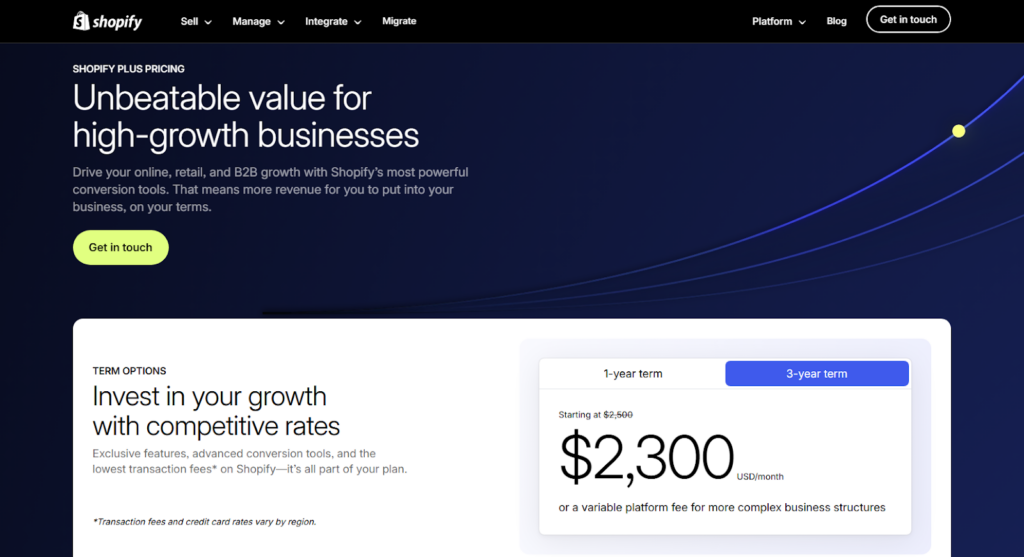
For more complex and high-volume businesses, the pricing may be variable and based on their revenue and business model, requiring a consultation with Shopify sales for a specific quote.
So, you’re thinking about B2B with Shopify Plus? Awesome.
The next section talks about what steps to take for Shopify B2B.
How to Get Started with Shopify Plus?
Here you’ll find the step-by-step process to get started with Shopify B2B wholesale business:
Step 1: Upgrade to Shopify Plus
First things first, B2B functionality is exclusive to Shopify Plus. If you’re currently running a standard Shopify plan, you’ll need to level up.
Talk to Shopify sales or a Partner agency before jumping in. These folks can offer insights tailored to your specific business needs, ensuring that the upgrade is a strategic move rather than a shot in the dark.
They can also help you understand the full scope of what Shopify Plus offers beyond B2B.
Step 2: Decide on Your Store Strategy
Now with Shopify Plus, you need to make the choice between:
- Single Storefront: Sell to both B2B and D2C customers from one store using personalized experiences.
- Dedicated B2B Store: Create a separate storefront exclusively for wholesale customers.
This decision is very crucial and depends heavily on your business model and customer base.
If you’re dealing with vastly different product lines or customer experiences, a dedicated B2B store might be the way to go. It keeps things clean and prevents confusion. However, if your products and branding align well for both audiences, a single storefront can be more efficient.
Here you need to think about:
- How distinct are your B2B and D2C customers? Do they have vastly different needs and expectations?
- Do you offer different products or variations for your B2B customers?
- Can your brand seamlessly cater to both audiences, or does it need to be tailored?
Step 3: Set Up Companies in Shopify Admin
Once you’ve settled into Shopify Plus and figured out your store format, it’s time to lay the foundation for your B2B operations—and that starts with setting up “Companies.”
In Shopify B2B, companies are the backbone of everything.
A company is a customer account with layers—each one can have multiple locations, payment terms, contacts (buyers), and personalized settings. Instead of treating every B2B customer like a simple user profile, you can build out real-world complexity—just like how businesses actually operate.
For example, if one of your wholesale customers has a head office and three regional warehouses, you can define that right in their company profile. And if different contacts need to place orders from different locations or need access to specific catalogs, you can do that too.
This is where you start tailoring the experience for your high-value B2B buyers—and building trust by respecting how they work.
Step 4: Configure B2B Price Lists
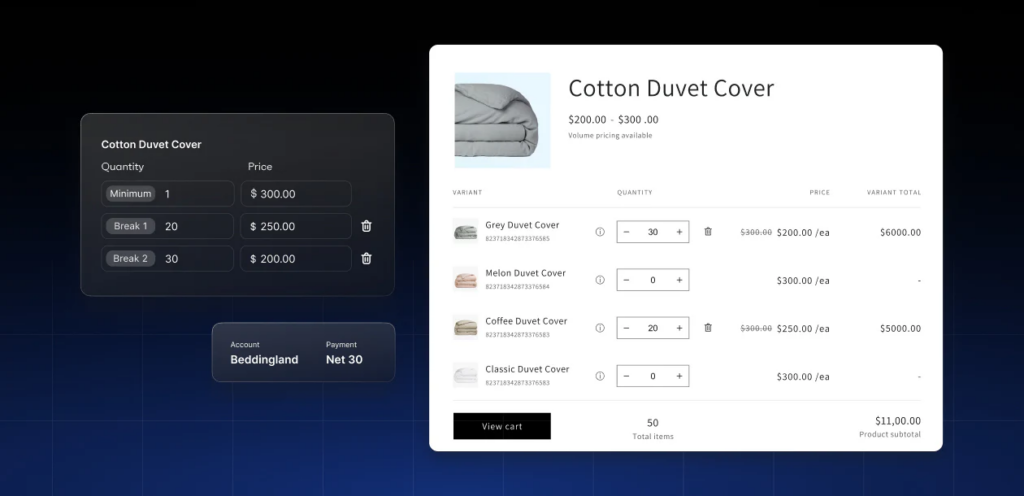
Wholesale isn’t retail, and that means pricing needs to be flexible, dynamic, and contextual.
Shopify Plus gives you the ability to create custom Price Lists tied to companies or even individual locations.
You’re not just setting discount rules—you’re defining exactly what each buyer pays per product (or variant), and even adjusting based on currency or geography if needed. This is key if you operate in multiple markets or serve different tiers of resellers.
Let’s say you’ve got gold-tier customers who get 40% off, silver-tier who get 30%, and new accounts that get 20%. You can build these into separate price lists and assign them to the appropriate companies.
Want to go deeper? You can create volume-based pricing too—perfect if you want to encourage larger orders.
If you’ve ever had to maintain pricing in spreadsheets or sync it manually across platforms, this part will feel like a breath of fresh air.
Step 5: Customize Payment and Checkout Options
B2B buyers expect a different checkout experience than your everyday D2C shopper.
They don’t just pull out a credit card and check out—they often need to use purchase orders, get invoiced, or have approvals baked into the workflow.
Shopify Plus supports all of this.
You can offer net payment terms (like Net 30 or Net 60), accept manual payments like ACH or wire transfers, and even allow customers to pay after the goods are delivered. You can set these preferences at the company level so each buyer sees only the payment methods that make sense for them.
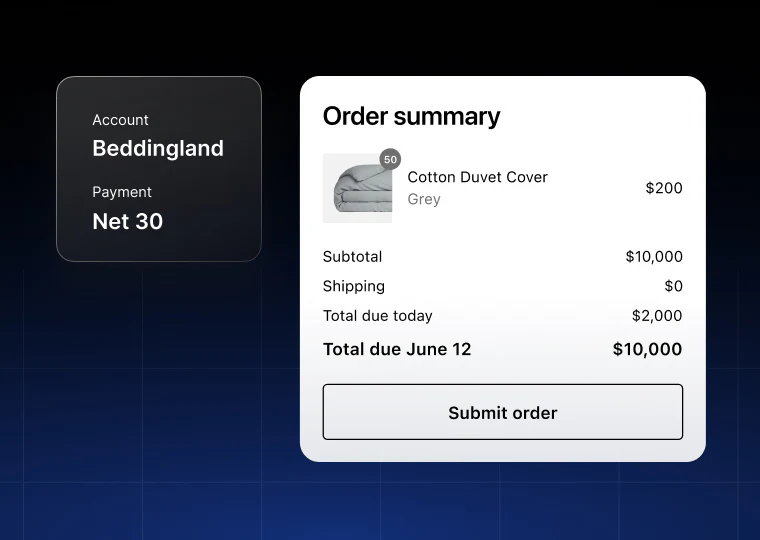
And yes, you can still offer credit card checkout if that’s needed—but now you’re giving buyers the flexibility they’re used to when ordering wholesale. Which is a huge trust-builder, especially for high-value transactions.
Step 6: Personalize the Storefront Experience
Shopify Plus lets you personalize your storefront based on who’s logged in—and this goes way beyond hiding prices.
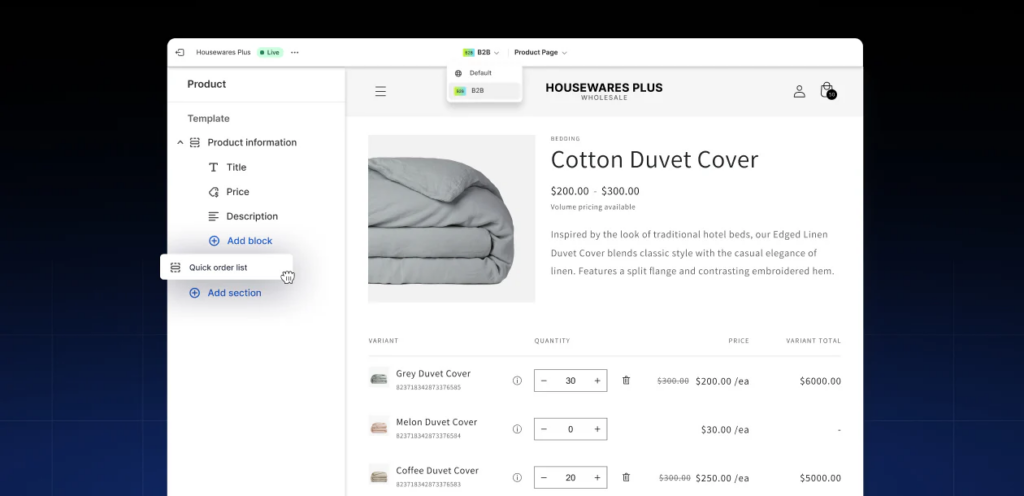
Using Liquid logic, customer tags, or Shopify’s new storefront contextualization, you can
- show or hide entire collections,
- customize headers,
- surface relevant pages, and
- guide buyers to what matters most to them.
You can even change the theme look and feel subtly for B2B buyers if needed.
For example:
B2B customers might need to see bulk packs and downloadable spec sheets. D2C shoppers might need lifestyle photography and a size guide. You can serve both in the same store if you want to—it’s just a matter of creating those rules.
This kind of tailored experience is what makes buyers feel like they’re shopping in a platform designed for them—not just squeezed into a consumer flow.
Step 7: Set Up B2B Shipping and Fulfillment Rules
Shipping gets a bit more complex when you enter the B2B world.
You’re often dealing with bulk shipments, freight logistics, or staggered deliveries. Some customers want to pick up from a warehouse; others expect you to manage everything end-to-end.
Shopify Plus gives you the flexibility to build shipping profiles that reflect your real-world operations. You can:
- Set up custom shipping rates based on volume or destination
- Offer different shipping methods for different companies or locations
- Handle split shipments for backorders or pre-orders
And if you’re working with a 3PL or ERP, you can integrate them directly so that order routing, fulfillment updates, and inventory sync are all handled automatically. This helps you stay accurate and scalable—without the manual hassle.
Step 8: Test the Experience
Before inviting your B2B customers in, run through the full buying process as if you’re one of them. Log in as a test company and double-check:
- Are the right products visible?
- Is the pricing correct?
- Are the payment and shipping options working as intended?
- Does the checkout flow make sense?
- Are email notifications showing the right messaging?
Make sure it’s friction-free, intuitive, and branded the way you want it. The more seamless it feels, the more likely it is that your buyers will embrace the platform without needing constant support.
Learn more: Is Shopify Plus Worth Investing?
FAQs about Shopify B2B Wholesale
What is Shopify Plus?
Shopify Plus is an enterprise-level e-commerce platform that offers advanced features and tools for high-growth businesses, including those selling B2B.
Is Shopify suitable for B2B?
Yes, Shopify is suitable for B2B and offers many B2B capabilities, but they are primarily available through the Shopify Plus plan. Shopify Plus provides a suite of features and tools specifically designed for running a business-to-business (B2B) or wholesale operation within the Shopify ecosystem.
What are the limitations of B2B on Shopify?
Orders have a maximum of 500 line items. If a customer places an order for more than 500 different products or variants, then the order will fail. Draft orders have a maximum of 200 line items. If you receive or create a draft order with more than 200 different products or variants, then the draft order will fail.
What are the payment terms for Shopify B2B?
Your customers pay for orders in a specific time period that you select. The available terms are net 7, net 15, net 30, net 45, net 60, and net 90. For example, if you select net 30 terms, then your customer needs to pay for an order within 30 days.
What sales channels are commonly used in B2B?
Common sales channels include phone, email, fax, field sales reps, trade shows, showrooms, e-commerce marketplaces, and e-commerce sites.
How big is the B2B e-commerce market?
The global wholesale market was worth $7.7 trillion in 2023, which is more than double the size of the direct-to-consumer (DTC) market. The B2B e-commerce market is expected to grow by 18% every year from 2023 to 2030.
Final Thoughts!
The shift to digital B2B commerce isn’t just a trend—it’s a fundamental evolution in how wholesale business operates. The question isn’t whether to make this transition, but how quickly and effectively you can embrace it.
Shopify Plus offers the tools, flexibility, and scalability to create exceptional B2B experiences that will delight your customers and drive sustained growth. And with the right partner guiding your journey, the path to B2B excellence becomes clear and achievable.
Our approach is collaborative, working closely with your team to ensure that your unique business requirements are met.
Ready to transform your wholesale operations?
Let’s talk about how we can help you leverage Shopify Plus to capture your share of the $7.7 trillion B2B opportunity.
Sources:






Post a Comment
Got a question? Have a feedback? Please feel free to leave your ideas, opinions, and questions in the comments section of our post! ❤️